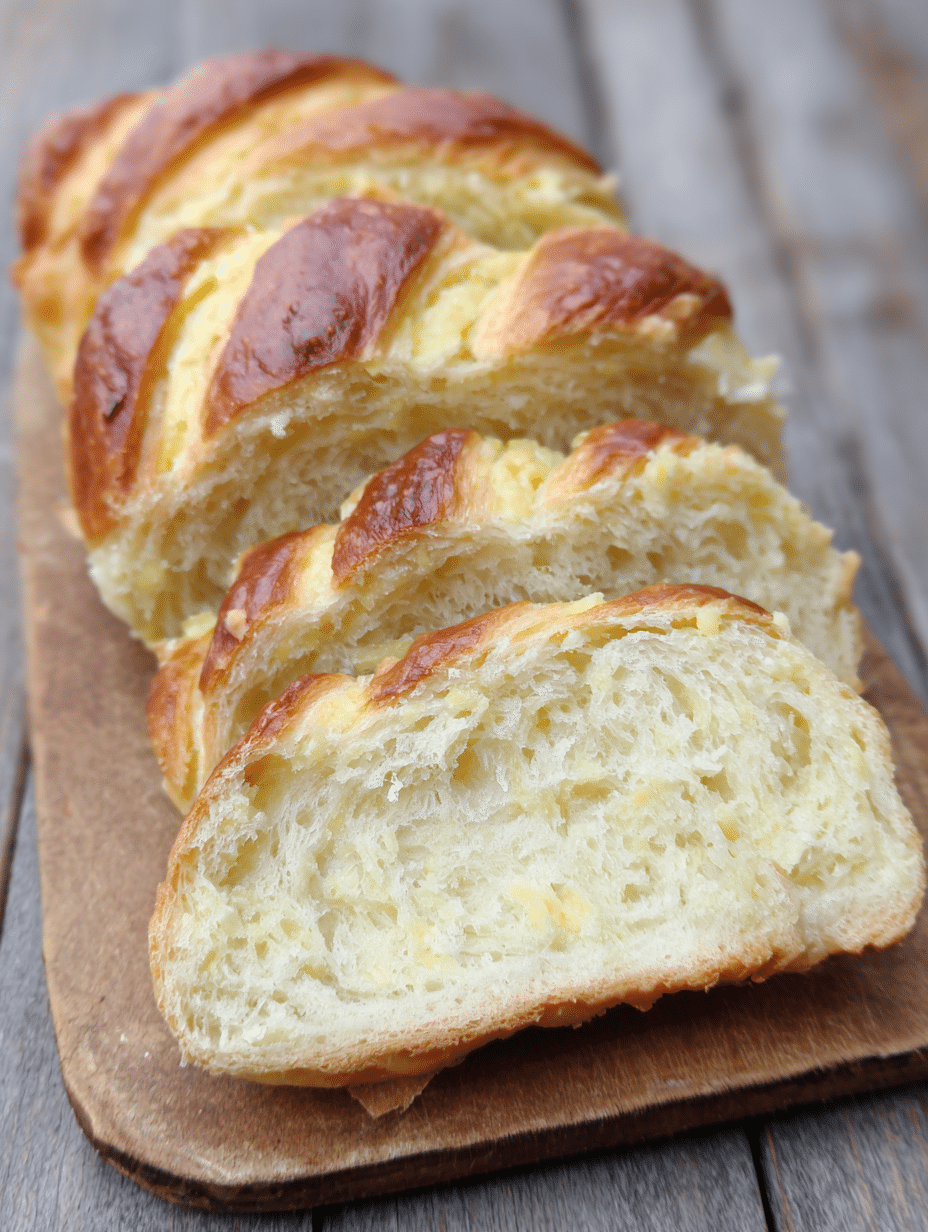If you’ve ever stood in your kitchen, torn between the tangy depth of sourdough and the buttery elegance of a croissant, this recipe is your dream come true. In this article, I’ll walk you through creating a sourdough croissant loaf that combines natural fermentation with rich laminated layers. We’ll cover everything from starter prep to folding technique, and I’ll share my favorite pro tips for achieving bakery-style results at home.
Table of Contents
Table of Contents
Let’s begin with the story behind this flaky, golden beauty and how it became a new favorite in my kitchen.
Print
Sourdough Croissant Loaf Recipe
- Total Time: 12–16 hours
- Yield: 1 loaf 1x
- Diet: Vegetarian
Description
This sourdough croissant loaf is where buttery layers meet tangy depth. A laminated masterpiece that rises with natural fermentation and bakes into golden, flaky glory.
Ingredients
300g bread flour
100g all-purpose flour
100g active sourdough starter (fed and bubbly)
150ml cold water
10g salt
200g unsalted butter (for laminating)
1 egg (for egg wash)
Instructions
1. In a large bowl, mix both flours, sourdough starter, water, and salt until a rough dough forms. Rest 30 minutes.
2. Knead until smooth. Cover and bulk ferment at room temp for 4–6 hours until doubled.
3. Flatten the dough and chill. Meanwhile, shape butter into a flat square between parchment.
4. Encase the butter in the dough and roll out. Fold and chill 3 times like croissant dough.
5. After final fold, shape into a loaf. Place in a loaf tin and proof overnight in the fridge (or 4–6 hours at room temp).
6. Brush with egg wash and bake at 200°C (390°F) for 35–40 minutes until golden and fragrant.
Notes
Add shredded cheese or fresh herbs between the folds for a savory variation.
Make sure your butter and dough stay cold during lamination to prevent tearing.
- Prep Time: 1 hour
- Cook Time: 40 minutes
- Category: Bread
- Method: Laminated baking
- Cuisine: French-inspired
Nutrition
- Serving Size: 1 slice
- Calories: 290
- Sugar: 1
- Sodium: 230
- Fat: 18
- Saturated Fat: 11
- Unsaturated Fat: 6
- Trans Fat: 0
- Carbohydrates: 26
- Fiber: 1
- Protein: 5
- Cholesterol: 60
Keywords: sourdough croissant loaf, laminated sourdough, sourdough bread
The Story Behind My Sourdough Croissant Loaf Obsession
Inspired by tradition, shaped by curiosity
Somewhere between a craving and a challenge, this sourdough croissant loaf was born in my kitchen on a chilly Saturday morning in West Lafayette. I had a jar of bubbly starter on the counter and a deep itch to laminate but I didn’t want to make individual croissants. What if I could shape it into a loaf, capturing the same flaky texture in every slice?
There’s something incredibly grounding about working with sourdough. The dough has a mind of its own, and it teaches you to listen. That day, I folded the butter into my dough with patience and hope and when I pulled that loaf out of the oven, golden and puffed, I knew it was magic. Crispy edges, soft interior, layers that tore apart like pastry. I sliced it warm, spread it with raspberry preserves, and never looked back.
Since then, it’s become a staple when I want to impress without overcomplicating brunch. If you love my flaky sourdough biscuits or crave the rich chew of garlic herb sourdough bread, this loaf will hit all the right notes.
Why this sourdough croissant loaf is worth your time
This recipe is more forgiving than traditional croissants but just as impressive. You’ll get that signature crackle with every bite thanks to cold fermentation and buttery lamination. And since it’s shaped like a loaf, it’s perfect for slicing, toasting, or devouring as-is.
Using an active sourdough starter means your loaf will have complex flavor, long fermentation benefits, and that unmistakable tang. The process takes time, but most of it is hands-off. And every step especially the folds builds anticipation for that final golden rise.

Ready to roll (and fold)? In the next section, we’ll talk about how to get your dough and butter perfect for lamination.
Mastering the Sourdough Croissant Loaf Technique
Building the perfect dough base
When making a sourdough croissant loaf, the foundation matters. You’re aiming for strength and elasticity, but not too much toughness. This dough uses a mix of bread flour and all-purpose flour, which gives just enough chew while staying tender. The high protein content in bread flour supports the layers during lamination, while all-purpose softens the crumb just slightly.
Start by mixing your flours, water, salt, and a fed sourdough starter. Don’t rush hydration let the dough rest after mixing (autolyse) so the flour can fully absorb the water. This 30-minute rest works wonders, allowing gluten to develop naturally without over-kneading.
After resting, knead just until smooth and elastic. Then it’s time for the bulk fermentation. At this stage, the sourdough does its magic, creating flavor and air pockets. A warm, draft-free spot helps, and you’ll want to ferment for 4–6 hours or until the dough doubles in size. A simple poke test can tell you when it’s ready.
Need a simpler loaf first? Try this easy sourdough bread recipe to get familiar with dough development before diving into lamination.
Cold butter, warm confidence: laminating like a pro
Lamination sounds fancy, but once you get the feel for it, it becomes almost meditative. To laminate this sourdough croissant loaf, the key is cold butter and chilled dough. Warm butter will ooze out during folds, ruining your layers. So work quickly and always rest the dough in the fridge between turns.
Start by flattening your butter into a square and rolling out your dough into a larger rectangle. Encase the butter like a letter fold, then roll it out again. Repeat this roll-and-fold sequence three times, chilling the dough for at least 30 minutes between each round.
Each fold builds more delicate layers. Don’t worry if the edges crack a bit it’s all part of the rustic charm. If you’ve tried my sourdough cinnamon roll focaccia, you already know how layering dough can transform a simple recipe into something exceptional.
Once the folds are done, you’re almost there. Just shape the dough into a loaf, tuck it into a pan, and let it proof again this time slowly and cold.
From Proof to Puff: Baking the Ultimate Sourdough Croissant Loaf
Timing your proof for flaky perfection
This final rise is where the sourdough croissant loaf really comes alive. After shaping, you’ll either proof the dough overnight in the fridge or let it rise at room temperature for 4–6 hours. Cold fermentation is highly recommended it enhances both structure and flavor.
The loaf should puff up slightly in the pan, but don’t expect dramatic rise like traditional sandwich bread. That’s okay laminated dough isn’t about volume; it’s about layered lift. A gentle finger dent should spring back slowly, not instantly. That’s how you know it’s ready to bake.
If you’re new to this kind of fermentation, try starting with no-discard sourdough starter to simplify feeding and timing. It’s a helpful beginner path before jumping into advanced bakes like laminated sourdough.
Before baking, give it a confident brush with egg wash. That glossy crust? It comes from this one simple step. It also helps highlight all the beautiful folds you’ve worked so hard to create.
Baking tips for crisp crust and fluffy crumb
Now for the oven magic. Preheat your oven to 200°C (390°F). Bake the sourdough croissant loaf for 35–40 minutes, until deeply golden and visibly puffed. You’ll hear a faint crackle as it cools that’s the sound of good lamination.
The steam inside those butter layers helps create a crisp crust that shatters when you slice it. Want to dial it up? Try slipping a tray of ice cubes into the oven base in the first 10 minutes to add extra steam and encourage more lift.
Let the loaf cool at least 30 minutes before slicing. It’s tempting, but cutting too early can squash the layers. The inside should be airy and slightly custardy just like a hybrid of croissant and sourdough.
Serve warm with jam, toasted with butter, or topped with flaky salt for a savory snack. You can even transform leftovers into luxurious French toast.
For a savory version, check out this garlic cheese sourdough bread you can use the same lamination technique and tuck in cheese between the folds.
Next, let’s explore variations, storage tips, and creative ways to serve your sourdough croissant loaf so not a crumb goes to waste.
Variations, Storage & Creative Serving Ideas
Savory or sweet? Your loaf, your flavor
One of the best things about this sourdough croissant loaf is its versatility. Once you’ve mastered the base, you can customize it endlessly. Before the final fold, sprinkle in grated cheese (like Gruyère or cheddar), chopped fresh herbs, or even finely diced sun-dried tomatoes for a savory punch.
Want to go sweet? Layer in cinnamon sugar or a thin smear of jam between folds. You’ll get a swirl of flavor in every bite think of it like a naturally fermented danish loaf.
If you’re already a fan of sourdough discard cinnamon rolls, try adapting that filling into this croissant-style dough. The flake meets swirl combo is bakery-level delicious.
Don’t be afraid to get creative. The loaf format is perfect for experimenting because it supports the dough structure even with add-ins.
How to store and reheat your sourdough croissant loaf
Because of the rich butter content, this loaf stays soft for a couple of days. Store it in a bread box or wrapped loosely in parchment at room temperature for up to 2 days. For longer storage, slice and freeze then toast from frozen.
To revive that crisp crust, reheat slices in the oven at 350°F for 5–7 minutes. You’ll bring back the flaky magic without drying it out.
If you loved the buttery, rich texture of my sourdough French bread, you’ll adore how this croissant loaf toasts up. It’s perfect for fancy grilled cheese, open-faced egg sandwiches, or layered with brie and fig jam.
Serve warm for brunch, slice for sandwiches, or toast for a buttery afternoon snack. No matter how you enjoy it, this sourdough croissant loaf is one of those recipes that feels special every single time.
Frequently Asked Questions About Sourdough Croissant Loaf
What is a sourdough croissant loaf?
A sourdough croissant loaf is a hybrid bake combining naturally fermented dough with classic croissant lamination. It’s layered with cold butter and folded multiple times to create delicate, flaky layers then shaped into a loaf and baked until golden. The result is a rich, tangy, buttery bread with a crisp crust and soft, airy interior.
Can you laminate sourdough bread dough?
Yes, you can! Laminating sourdough dough follows the same method as traditional croissants, but the dough is naturally leavened instead of using commercial yeast. It takes longer to ferment but results in complex flavor and a beautiful rise when done correctly. Cold butter and proper chilling between folds are essential.
How long should I proof sourdough croissant dough?
You’ll proof the shaped loaf for 4–6 hours at room temperature or overnight in the fridge. The cold proof is ideal it slows fermentation and builds deeper flavor while also maintaining the dough’s structure. You’ll know it’s ready when it looks slightly puffed and springs back slowly when gently pressed.
Can I freeze sourdough croissant loaf?
Absolutely. You can freeze the baked loaf whole or sliced. Wrap it well and store for up to 2 months. To enjoy later, thaw at room temperature and toast in the oven to restore its flaky crust. It reheats beautifully especially if you froze it fresh.
Conclusion
Whether you’re just beginning your sourdough journey or you’ve been folding dough for years, this sourdough croissant loaf offers a satisfying challenge with bakery-worthy results. It combines technique and tradition, all wrapped in a golden, crackly crust. And once you’ve made it once, you’ll want it on repeat brunches, gifts, or just for the love of bread.





